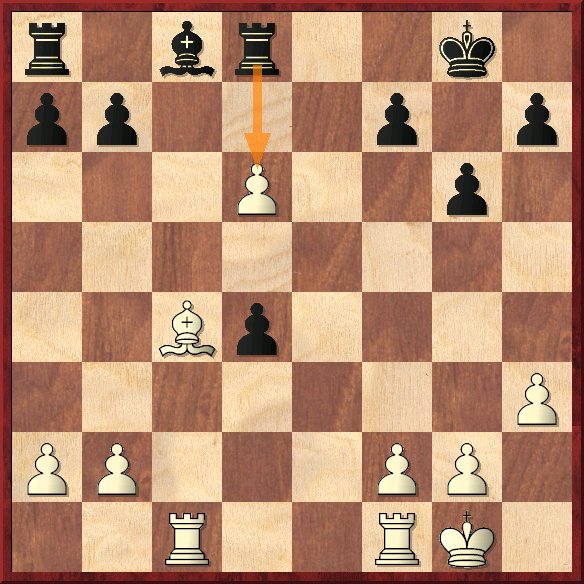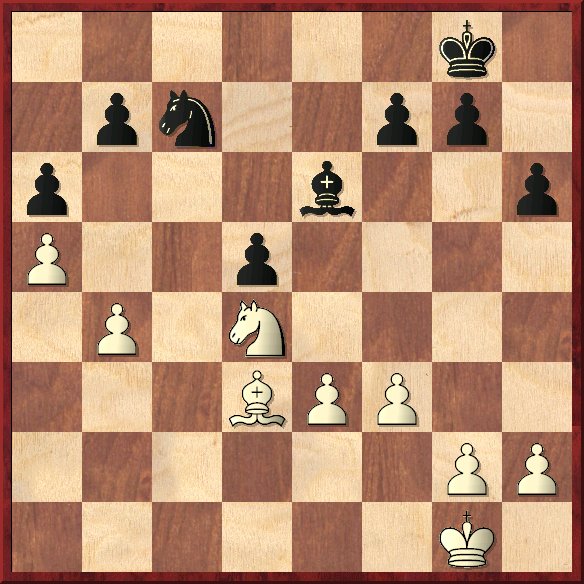|
“This is
old news, right?” or
The
European Champion’s taking on CC
Translated by ICCF-IM
Valer Eugen Demian
Yeah, I know; you’ve
heard it before: correspondence chess players are just cyber
chess players faking it with a click of their mouse. Of
course they are your 21st century version of your
yesterday’s play from the books, or of “My neighbor is a
better chess player than yours” old tune. Personally I do
not agree with this. Of course no OTB GM player would trade
his title for the ICCF-GM one, but in essence a lot of the
strong OTB players look at correspondence chess with
respect. This is not just a simple statement without proof,
but rather a conclusion after talking to several OTB
players. Moreover it is interesting to note the higher the
rating an OTB player has, more respect and attention is
given to correspondence chess. Possibly your regular OTB-GM
will not know the name of the current ICCF World Champion,
but maybe this is something ICCF could consider fixing in
the near future!
Not long ago it was my
pleasure and challenge to organize a chess festival in
my native city of Alba-Iulia. Our VIP guest was no other
than GM Dieter Nisipeanu,
current European Champion. If you just found out about this
chess festival,
you might wish to read my report published by Chessbase at:
http://www.chessbase.com/newsdetail.asp?newsid=2784
Here I
just want to elaborate a bit how correspondence chess was a
relevant part of it.
Last
May I gave Dieter a database containing some correspondence
chess games.
He was preparing for the European Championship and I thought
he might want to have a
look at some of them. Fast forward to the time of the
festival; I asked him if he ever had the
chance to look at it. His response came somewhat surprising,
but refreshing:
“Of
course I looked in the database before every game from
European Championship, not only before the tournament”
For him
this database seemed like a good possibility to still get an
edge in home preparation,
since everyone these days uses all sort of databases in
general.
Our
schedule and the nature of the festival – promoting chess
with a VIP leading the
way – did not give Dieter a chance to use any database
before his simultaneous. Still he
had to face 2 solid correspondence chess players: Boris
Gusan (member of Romania’s
ICCF Olympic team, Olympiad XVI preliminaries) and Daniel
Cinca (our second board
in the Preliminaries of the European Team Championship, 7th
edition). None of them lives
in Alba-Iulia, but both did everything necessary to be there
and meet Dieter. Daniel for
example traveled 300Km and got into the city at 2:00a.m. in
the day of the festival.
I was
also curious to see how they would hold their own. Both are
category I
OTB players in Romania, which means something around a
rating range of (1800-2200).
On top of this only Daniel still plays in OTB competitions.
Boris plays rarely and no more
than your regular blitz sessions with your buddies kind of
thing. Given this data, how
many would bet on a surprise for either?... Let’s see the
games!
Nisipeanu,Dieter -
Gusan,Boris [B04]
Alba Iulia - simul,
25.11.2005
[ Marius Ceteras ]
1.e4
Nf6
Normally Boris plays the Sveshnikov Sicilian in his CC games
,
but Alekhine Defence remains his pet opening.
2.e5 Nd5 3.d4 d6 4.c4 Nb6
5.exd6 cxd6 6.Nc3 g6 7.Be3 Bg7 8.Rc1 0–0 9.h3
[The main line is 9.b3 , but
Dieter likely wanted to avoid a
theoretical contest with a CC specialist. ]
9...Nc6
[9...e5 10.dxe5 dxe5 11.Qxd8 Rxd8 12.c5 N6d7
13.Bc4 Nc6 14.Nf3 leads to positions
similar to the line 9.b3 e5 10.dxe5 dxe5 11.Qxd8 Rxd8 12.c5
N6d7 13.Bc4 Nc6 14.Nf3.]
10.Nf3 e5
[An alternative is 10...d5 11.c5
Nc4 12.Bxc4 dxc4÷ Gipslis,A-Mnatsakanian,E/Soviet Union
1967]
11.dxe5 dxe5 12.Qxd8
This seems to be a theoretical
novelty. [White has previously played 12.c5 Nd7 13.Bc4 ,
while in December 2005, so after the simul, Saltaev
introduced the move 13.Bb5.]
12...Rxd8 13.c5 Nd5
[It was worth considering
13...e4!? 14.Nd2 (14.Nxe4 Nd5 15.b3 Nxe3 16.fxe3 Nb4©)
14...Bxc3 15.bxc3 Nd5 16.Nxe4 Nxe3 17.fxe3 Be6©]
14.Nxd5 Rxd5 15.Bc4 Rd8
[15...Rd7 16.Nd2²]
16.Ng5 Rf8 17.Ne4
White gained a slightly advantage
due to his pawn majority
on the queenside and better positioned pieces.
17...Nd4!
With the idea Bd7-c6.
18.Bxd4
[18.b4!?²]
18...exd4 19.Nd6 Be5 20.0–0
[20.Rd1 b6!„]
20...Bxd6 21.cxd6 Rd8

22.Rfe1 Rxd6
[22...Kg7 23.Bb3ƒ]
23.Re8+ Kg7 24.Bb3! Rc6
Black defends too passively.
[Better would have been 24...d3! 25.Rc7 (25.Rcxc8 Rxc8
26.Rxc8 d2 27.Bd1 Re6!=) 25...d2 26.Rxf7+ Kh6 27.Rh8
(27.Bd1 Be6!) 27...d1Q+
28.Bxd1 Rxd1+ 29.Kh2 g5! 30.Rfxh7+ Kg6 31.Rc7 Rd2 32.Rg8+
Kh6 33.Rf8! Kg6
34.b3 Rxa2 35.Rg8+ Kf6 (35...Kh6? 36.Rd8!!±) 36.Rgxc8
Rxc8 37.Rxc8 Ra3 38.Rc3 a5
with good chances for a draw]
25.Rxc6 bxc6 26.Re7 Ba6
[The last chance was 26...Be6!
27.Bxe6 Kf6 28.Rxf7+ Kxe6 29.Rxh7 where Black
could hope the rule "All rook endings are draw", would be
confirmed again.]
27.Rxf7+ Kh8
[27...Kh6 28.f4! with the idea g4]
28.Rc7± Rc8 29.Rxa7 Be2 30.f3
c5 31.Kf2 Bd3 32.Bd5 c4 33.Ra8 Rxa8 34.Bxa8 Kg7?!
[34...c3 35.bxc3 dxc3 36.Ke3 Bf1
37.f4+-]
35.Be4 1–0
Nisipeanu,Dieter - Cinca,Daniel [D36]
Alba Iulia - simul, 25.11.2005
[ Marius Ceteras ]
1.d4 Nf6 2.c4 e6 3.Nc3 d5
4.cxd5
A good choice for a simul, where the simultanist is
interested to avoid double-edge positions.
4...exd5 5.Bg5 Be7 6.e3 c6
7.Bd3 Nbd7 8.Nge2
This set up was introduced by
Marshall, but gained popularity in the 1980s when Kasparov
scored two impressive wins against Ulf Anderesson and Boris
Spassky. Perhpas it's worth mentioning that Kasparov used it
first time in a simul given in Zurich 1988.
8...0-0
[8...Nh5 9.Bxe7 Qxe7 10.g4 Nhf6
11.Ng3 h6 12.h3 Nb6 13.Qd2 Bd7 14.b3 g6
15.a4 a5 16.f3 h5 17.g5 Qd6 18.Nge2 Ng8 19.e4 Ne7 20.Qf4
Qxf4 21.Nxf4 0-0
22.Nce2 h4 23.Ng2 Kg7 24.Kd2 dxe4 25.fxe4 Rad8 26.Raf1 Rh8
27.Ne3 Rh5
28.Rfg1 Bc8 29.Kc3 Rhh8 30.Nf4 Rd6 31.Bc2 Na8 32.Nc4 Rdd8
33.Nxa5 Nc7
34.Rf1 b5 35.Rf3 Rhf8 36.Rhf1 bxa4 37.bxa4 f6 38.Nxg6 Nxg6
39.gxf6+ Kh6
40.Nxc6 Rd6 41.d5 Rxc6+ 42.dxc6 Ne6 43.e5 Nxe5 44.Re3 Ng6
45.f7 Ngf4
46.Bb3 Kg7 47.Re4 Rxf7 48.Bxe6 Nxe6 49.Rxf7+ Kxf7 50.Rxh4
Ke7
51.Rh8 Ba6 52.h4 1-0 Kasparov,G-Spassky,B/Barcelona
1989]
9.Qc2 Re8 10.0-0 h6
Not the most accurate move. [The
main line is 10...Nf8 Here are two games of
Kasparov, which influenced the development of this opening
system
11.f3 (11.a3 g6 12.b4 Ne6 13.Bh4 a6 14.f3 Ng7 15.Bf2 h5
16.h3 Nh7 17.e4 Bh4
18.Qd2 Bxf2+ 19.Rxf2 h4 20.Bc2 Nh5 21.Nf4 Nxf4 22.Qxf4 Qf6
23.Qd2 Be6
24.e5 Qg7 25.Na4 Nf8 26.Qg5 Qh8 27.f4 f6 28.exf6 Bf7 29.Bxg6
Bxg6 30.f5 Kf7
31.Nc5 Bh5 32.Nxb7 Nd7 33.Nd6+ Kf8 34.Qxh4 Nxf6 35.g4 Re7
36.g5 Rd7
37.gxf6 Rxd6 38.Re1 Re8 39.Rxe8+ Kxe8 40.Re2+ Kf8 41.Re6 Qh6
42.Rxd6 Qe3+
43.Qf2 Qxh3 44.Qf4 1-0 Kasparov,G-Beliavsky,A/Moscow
1987)
11...Be6 12.Rae1 Rc8 13.Kh1 N6d7 14.Bxe7 Rxe7 15.Nf4 Rc7
16.Qf2 Nf6
17.e4 dxe4 18.fxe4 Rcd7 19.d5 cxd5 20.Bb5 Rc7 21.exd5 Bd7
22.Be2 Rc8
23.Qxa7 b6 24.Qa6 Ne4 25.d6 Nxd6 26.Nfd5 Re5 27.Qxb6 Nf5
28.Qxd8 Rxd8
29.Bd3 Rxe1 30.Rxe1 Ng6 31.a4 Nd4 32.a5 Kf8 33.Bxg6 hxg6
34.Rd1 Ne6
35.Nb6 Bc6 36.Rxd8+ Nxd8 37.b4 Ne6 38.b5 1-0
Kasparov,G-Andersson,U/Belfort 1988]
11.Bh4 Ne4
Now the plan Nd7-f8-g6 is no
longer possible, therefore Black
must use this freeing maneuvre in order to keep the balance.
12.Bxe7 Qxe7 13.Rae1 Ndf6
14.f3 Nxc3 15.Nxc3 Be6 16.Qf2 c5!
A very good reaction. Black
accepts an inferior position with an isolated pawn,
but definitely prevents White from playing e3-e4.
17.dxc5 Qxc5 18.Ne2 Rac8
19.Nd4+/=
White has a long term edge, but
practice has shown that such positions with an isolated pawn
are playable. A turning point in the evaluation of these
positions was the famous game
Flohr-Capablanca, Moscow, 1935 in which the Cuban genius
proved the weak side
can hold the position even in the endgame Knight vs Bad
Bishop.
19...a6
I don't like this move. Normally
White's only plan to win is to trade
the rooks and exploit the weakness of the dark squares.
Therefore Black must
avoid to move his pawns on the light squares. [Better was
19...Re7 with the idea Rec7.]
20.Qd2 Qb6 21.Rc1 Rxc1
22.Rxc1 Rc8 23.Rxc8+ Bxc8 24.Qc3 Be6 25.b4!
Of course, Nisipeanu masters much
better such positions. He doesn't miss
the opportunity to fix Black's pawns from the queenside on
light squares.
25...Ne8!
Swaping queens is a good idea
here.
26.a4! Qc7 27.Qxc7 Nxc7
28.a5!+/-

White
has a clear advantage, but converting it into a win is not
an easy task at all.
Now Black would have to bring his king to the center and set
his pawns from the
kingside on dark squares. It would have to be enough for a
draw with an accurate defence.
28...Kf8 29.Kf2 Ke7 30.g4
g6?!
A move that clearly proves Black
doesn't know this typical endgame. I recall that I
have read somewhere the difference between a master and an
amateur is made by the
number of typical positions they know. Perhaps there is some
truth is those words.
31.h4 Ne8
[ 31...g5!? ]
32.Ke2 Nf6
33.g5!
Now I think that Black might be
lost. With all pawns positioned on light squares,
his chances to survive are minimal. Additionally Black's
task becomes more
and more difficult because we are closing to the end of the
simul and the number
of opponents decreases. Thus Daniel had to play faster.
33...hxg5 34.hxg5 Ne8 35.Nb3
Bc8 36.Nc5 Nc7 37.Kd2 Ne6
38.Nxe6 Bxe6 39.Kc3 Kd6 40.Kd4 Bd7 41.Bc2 Be6 42.Bb3
[42.f4 Bg4 43.Bb3 Bf3 (43...Be6
44.f5!! Tired after 6 hours of walk and play,
Dieter missed this winning idea. 44...gxf5 45.Ba2 Zugzwang!
45...Kc6
(45...f6 46.g6 Bg8 47.Bb1+-) 46.Ke5 Kb5 47.g6 fxg6
48.Kxe6 Kxb4 49.Bxd5 Kxa5 50.Kf6+-) ]
42...Kc6 43.Ba4+
[43.Ba2? Kb5! 44.Bxd5 Bxd5 45.Kxd5
Kxb4 46.f4 Kxa5 47.e4 b5 48.f5 b4
49.Kc4 Ka4 50.e5 b3 51.Kc3 Ka3 52.e6 fxe6 53.fxg6=; White
could have won by
43.f4! Kd6 (43...Kb5 44.Bxd5 Bxd5 45.Kxd5 Kxb4 46.e4 Kxa5
47.f5 b5 48.e5 b4
49.Kc4 Ka4 50.e6+-) 44.f5!! Same as above! 44...gxf5
45.Ba2 Zugzwang! 45...Kc6 (45...f6
46.g6! Bg8 47.Bb1+-) 46.Ke5 Kb5 47.g6 fxg6 48.Kxe6 Kxb4
49.Bxd5 Kxa5 50.Kf6+-]
43...Kd6 44.b5
[44.Bb3 Kc6 45.f4! still wins]
44...axb5 45.Bxb5 Bh3 46.Be8
Be6 47.f4 Ke7 48.Ba4 Kd6 49.Bc2?
[Nisipeanu misses a new
opportunity to win by 49.Bb3! Zugzwang! 49...Kc6
50.Ke5! (The idea 50.f5 no longer works in
view of 50...gxf5 51.Ke5 Kb5 52.g6 fxg6
53.Kxe6 Kxa5 54.Bxd5 Kb4 55.Ke5 Kc3 56.Kf4 Kd2 57.Bxb7
Ke2!!=) 50...Kb5
51.Bc2! Bg4 (51...Kxa5 52.Bxg6+-) 52.Kf6 Kxa5
53.Kxf7+-]
49...Bf5!
[49...Bf5 50.Bb3 Be4!
(50...Be6? 51.Ba2! Kc6 52.Ke5 Kb5 53.Bb1+-) 51.Ba4 Bf5=]
1/2-1/2
Hope
these two samples have changed a bit your perception about
cyber chess players,
or at least about two of them. Not bad for two guys away
from their optical mice and
silicon brains. Will I push it a bit too far thinking about
a possible rematch under
correspondence chess conditions? Yes, you think? Yeah, I’m
just letting my carbon
imagination run to the N-th ply here and still no horizon
effect in sight
J
|